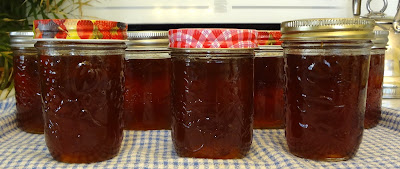I could just leave it at that — a photo of a bottle of marmalade, gleaming in the sun, the finished product of a satisfying kitchen task.
It would send the wrong message though. Making marmalade is a big, time-consuming job, hardly worth doing if it wasn't so delicious spread on your toast the morning after.
Marmalade is made with Seville oranges which aren't always readily available. There's usually a fairly short window of opportunity for snagging them and sometimes, it involves stalking the stores so you don't miss them if it happens to be a small shipment. Dan found them this year at Pete's Frootique, the lovely market in downtown Halifax (also in Bedford) where you can often find unique and unusual fruits and vegetables.
Seville oranges have tough, usually quite nubbly, thick skin and they're chock-full of seeds. They're bitter. They look like other oranges but they're not.
Marmalade is bitter by nature but even still, you don't want the bitterness of pith. I use a vegetable peeler to strip the orange zest — and the zest of one lemon. Try to get as little of the white as possible
After the peeling comes the juicing. You'll be struck when you open a Seville orange by how ugly it is. All seeds and membrane and unpleasant colour. In spite of that, there's lots of juice. You strain the juice through a sieve to catch all the seeds and pulp and then you pull out all the membranes and put them with seeds and pulp in a square of cheesecloth and make a little bag.
The bag goes into the pot of juice with the chopped peel. The seeds, membranes and pulp contain a lot of the natural pectin and that's what will thicken your marmalade.
You have to boil this until the peel becomes squishy; meanwhile, you're pressing on the cheesecloth to get as much pectin out of that stuff as possible. You'll know when it's time to add your sugar and begin the serious cooking.
I did everything right (pretty sure) but in spite of my best efforts, the mixture didn't gel. I tried the trick (at Dan's gentle suggestion) of putting the small plate in the freezer, then dropping some of the hot mixture on its coldness to see what would happen. As the cooking progressed, the mixture seemed to get a little thicker but when I poured some into a prepared bottle, it was way too liquid.
I was still cooking and stirring, way after midnight.
Finally, running out of time and energy and with no one around to sit in judgment, I went to the pickling and preserving drawer and found a small box of Cert-o with a package inside that had only been partly used. I felt vindicated because once I had done it, it wasn't as if I'd used a whole box of Cert-o. I used only a small part of a package! I stirred it in and within minutes, I was — with some relief — filling my bottles.
And here they are:
They're quite different from the last batch I made, in 2014. This year's batch is darker. Maybe the oranges were different; maybe the longer cooking time darkened the sugar; maybe the sugar itself — an organic unrefined sugar which is a little darker than the usual refined sugar — made the difference.
It's lovely though. There was a little bowl left as a taster. . .
. . .and I had it on my toast this morning.
Very good. I'm giving it a passing grade.








Please save some for me!
ReplyDelete